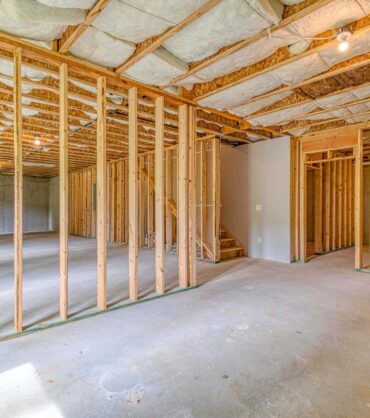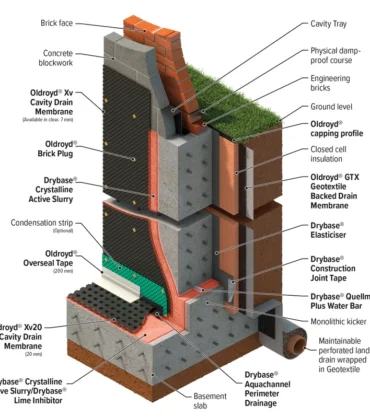Why Vapor Barriers Are Crucial for Effective Basement Waterproofing
Discover the importance and impact of vapor barriers in basement waterproofing. Learn about the types and installation process for effective prevention.
What are vapor barriers?
Vapor barriers are materials that are used to prevent the penetration of moisture and water vapor into a building structure, such as a basement. They are often used in construction to protect against moisture that can lead to mold, mildew, and other issues.
There are different types of vapor barriers, including plastic sheeting, foil-faced insulation, and specialized coatings. These materials are designed to create a barrier between the interior and exterior of a building, preventing moisture from seeping in.
The installation of vapor barriers is a crucial step in protecting a building from water damage. They are typically placed on the warm side of insulation to prevent condensation from forming in walls, ceilings, and floors.
Overall, the use of vapor barriers plays a significant role in basement waterproofing and can greatly impact the long-term health and stability of a building.
Importance of vapor barriers
Vapor barriers play a crucial role in maintaining the integrity of basement waterproofing. When it comes to protecting your basement from moisture and water damage, vapor barriers are an essential component of the waterproofing system.
One of the main importance of vapor barriers is that they help prevent moisture from seeping into the basement walls and floors. By acting as a barrier, vapor barriers reduce the risk of mold and mildew growth, as well as potential structural damage caused by water infiltration.
Furthermore, vapor barriers also help regulate the temperature and humidity levels in the basement, creating a more comfortable and stable environment. This is especially important in finished basements where maintaining a controlled climate is essential for the longevity of the space.
Another key role that vapor barriers play in waterproofing is preventing costly and time-consuming repairs. By keeping moisture at bay, vapor barriers help extend the lifespan of the basement and reduce the need for frequent maintenance and renovations.
In conclusion, the importance of vapor barriers in basement waterproofing cannot be overstated. From preventing moisture infiltration to maintaining a comfortable living environment, vapor barriers are an integral part of a comprehensive waterproofing system.
Types of vapor barriers
When it comes to choosing the right vapor barriers for basement waterproofing, it’s important to understand the different types available and their specific uses. There are several types of vapor barriers to choose from, each with its own set of characteristics and advantages.
One common type of vapor barrier is the polyethylene plastic sheeting, which is typically used in areas with high moisture levels. Another popular option is the foil-faced barrier, which has the added benefit of reflecting heat. Some homeowners may also opt for the asphalt-coated kraft paper, which provides excellent resistance to moisture.
For those looking for a more environmentally friendly option, there are also vapor barriers made from recycled materials, such as rubber or cork. These options may be more expensive, but they offer the advantage of being eco-friendly and sustainable. Additionally, there are also composite vapor barriers, which combine multiple materials for enhanced moisture resistance.
It’s important to consider the specific needs of your basement when choosing the type of vapor barrier to use. Factors such as the level of moisture present, the climate of the area, and the overall goals of the waterproofing project will all play a role in determining the best type of vapor barrier for your needs. Consulting with a professional waterproofing contractor can help you make an informed decision about which type of vapor barrier is best suited for your basement.
Installation of vapor barriers
When it comes to installing vapor barriers in basement waterproofing, there are a few key steps that need to be followed for successful implementation. The first step is to thoroughly clean and dry the surface that the barrier will be applied to. This ensures that the barrier will adhere properly and provide maximum protection against moisture. Once the surface is prepared, the vapor barrier can be installed using a variety of methods, including adhesive, mechanical fasteners, or heat welding.
Next, it is important to carefully seam and seal the vapor barrier to prevent any gaps or leaks that could compromise its effectiveness. This may involve overlapping the barrier sheets and using an appropriate sealing tape to create a continuous and watertight barrier. Additionally, attention should be paid to the placement of seams and corners to ensure that they are properly sealed and secure.
After the vapor barrier is installed, it is crucial to inspect the entire system to make sure that it is functioning as intended. This may involve conducting tests to check for any areas of weakness or vulnerability, as well as ensuring that the barrier is properly integrated with other waterproofing components such as drainage systems and sump pumps.
Proper installation of vapor barriers is essential for ensuring the long-term effectiveness of basement waterproofing systems. By following these key steps and paying attention to detail, property owners can protect their basements from moisture infiltration and the damaging effects of water damage.
Impact of vapor barriers on waterproofing
When it comes to ensuring the effectiveness of basement waterproofing, the impact of vapor barriers cannot be overlooked. These barriers play a crucial role in preventing the passage of moisture through the walls and floor of a basement, thereby protecting the integrity of the structure and maintaining a dry and healthy interior environment.
One of the key benefits of vapor barriers is their ability to reduce the risk of mold and mildew growth. By preventing moisture from seeping into the basement, vapor barriers help to create an inhospitable environment for these harmful microorganisms, thus promoting better indoor air quality and safeguarding the health of occupants.
Furthermore, the installation of vapor barriers can contribute to the overall energy efficiency of a building. By preventing dampness and condensation, these barriers help to maintain a stable indoor temperature and reduce the workload on heating and cooling systems, leading to potential energy savings and lower utility bills.
It is important to note that the effectiveness of vapor barriers in waterproofing depends on the choice of material and proper installation. When selecting a vapor barrier, factors such as permeability, durability, and compatibility with other waterproofing components should be carefully considered to ensure optimal performance and long-term protection against moisture intrusion.
| Types of Vapor Barriers | Installation Techniques |
|---|---|
| Sheet MembranesVapor Retardant PaintsPlastic Films | Proper sealing of seams and edgesUse of adhesive or mechanical fastenersIntegration with drainage system |
In conclusion, the presence of vapor barriers in basement waterproofing serves as a critical line of defense against moisture infiltration and its damaging effects. By understanding the impact of vapor barriers and investing in quality materials and installation, property owners can effectively protect their basements from water damage and preserve the structural integrity and value of their buildings.



![[GetPaidStock.com]-680786795b816 [GetPaidStock.com]-680786795b816](https://dmvwp.com/wp-content/uploads/2025/04/GetPaidStock.com-680786795b816-370x418.jpg)

![[GetPaidStock.com]-682c400c87c15 [GetPaidStock.com]-682c400c87c15](https://dmvwp.com/wp-content/uploads/2025/04/GetPaidStock.com-682c400c87c15-370x418.jpg)

![[GetPaidStock.com]-682c413fa898e [GetPaidStock.com]-682c413fa898e](https://dmvwp.com/wp-content/uploads/2025/03/GetPaidStock.com-682c413fa898e-370x418.jpg)